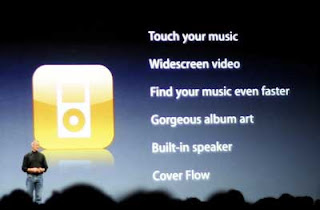Macworld Speech Canned!
Scathing attack on Stan Sigman's public speaking performance at Macworld totally justified!  Oh come on!
Oh come on!
I finally watched Steve Jobs' Apple keynote from the Macworld Expo last night to see for myself all the bruhaha about the iPhone. Cingular CEO Stan Sigman got up towards the end to contribute his $0.02 regarding the arrangements with Apple and what it would mean to Cingular.
And he was just dreadful! As Jobs said, this is not just about simple partnering; these guys are seriously innovating - the visual voicemail for a start. Stan started off fine, a bit tight in his breathing, but speaking well and with obvious sincerity. He then went off on a riff (with 4X6 cue cards) about the AT&T partnership, stodgily reiterated points about iPhone that Steve had already made very well, and read out what felt like extracts from Cingular's latest sales brochure.
Maybe he was going to use AutoCue and it broke. Maybe he was really sick and running a high fever and couldn't rely on his memory. Maybe a close family member had just died or he had received really bad personal news. But anything short of those three things does not excuse his appalling talk. He spoke for just under 6 minutes and it felt like an eternity. 6 minutes times 100 words per minute - a lousy 600 words - and he couldn't be bothered to learn it off by heart? Oh come on!
Apart from the first few moments, without the cards, he spoke in a too-slow, zero-enthusiasm, zero-sincerity, zero-energy monotone. If ever a presentation required energy, this was it. He didn't have to do a Steve Ballmer on it, but ... come on! [Incidentally, if any of the three reasons above were the cause of Stan's woeful performance, he should have stepped back and let one of his senior officers do the bit for him.]
Contrast that with when something went badly wrong for Steve, just after Stan left the stage. His clicker stopped working and (nightmare of nightmares!) the backup clicker didn't work either. He immediately went into a brief, relevant, and very funny improv about himself and Woz inventing a TV Jammer to mess up people's TV signal when they were back in high school and then segued smoothly back into his points about unit sales of Mobile phones when he got the nod from one of his technical team.
Seth wasn't too impressed (When you should stop improving) and neither was Rex ("worst canned speech of all time"). Macteens magazine live blog from the event "notes a lack of enthusiasm on the part of Mr. Sigman."I have always recommended watching speakers, both good and bad, as a learning exercise for anyone who wants to get serious about their public speaking and presentation skills and I have a library of examples. Stan's piece will be going straight into the "Godawful" folder.
Can't help but think about all the kudos that Singular gained from the exclusive link up with Apple just got a great big dent in it by the pitiful attempt at public speaking.
